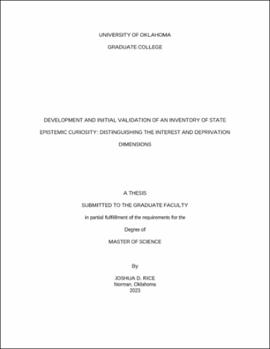| dc.description.abstract | The scholarly literature on epistemic curiosity has predominantly taken a trait-based perspective despite theory espousing its importance as a cognitive-motivational state relevant to learning, achievement, and creativity. Therefore, the purpose of the present study was to develop a state-based curiosity inventory for researchers to use to extend theory on self-regulated learning and performance, distinguishing between interest and deprivation dimensions. The interest dimension refers to the anticipated pleasure of new discoveries. The deprivation dimension refers to the desire to reduce uncertainty and close knowledge gaps. I first demonstrated the substantive content validity of new items and items adapted from existing scales, 24 items in total, per
Anderson and Gerbing (1991) using a convenience sample of psychology students. Second, I examined the structural and criterion-related validity of scores using a sample of approximately 248 college males tasked with learning a complex computer game per published lab studies on self-regulated learning and complex skill learning (e.g., Hughes et al., 2013; Hardy et al., 2014,
2018, 2023; Jorgensen et al., 2021). Structural validation analyses suggested a four-factor model, with interest and deprivation dimensions bifurcated into cognitive and emotional components, fit the data better than the a priori two-factor model. Discontinuous growth curve modeling controlling for cognitive ability, prior experience, the Big Five personality, and trait curiosity indicated interest-emotion and deprivation-emotion scores accounted for the variance in game performance. Third, I sought to develop short scales balancing the need for internal consistency reliability with predictive validity. My efforts to develop shorter scales identified viable short 3-to-4 item scales for interest-emotion and deprivation-cognition dimensions but more items need to be developed for measuring interest-cognition and deprivation-emotion dimensions. The results are discussed regarding the need for more work developing and validating scales of state epistemic curiosity. | en_US |

